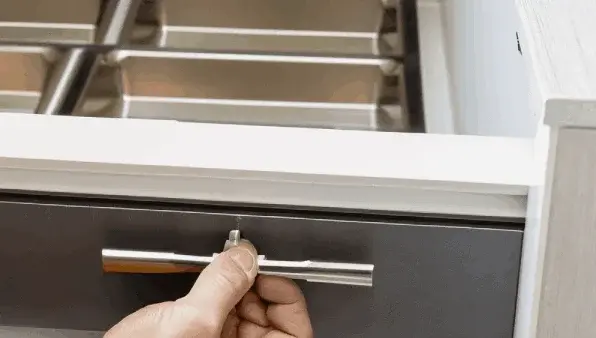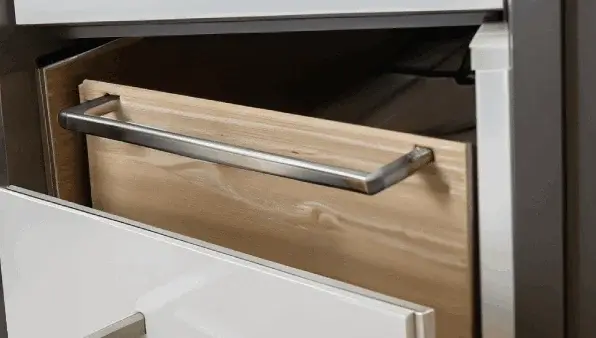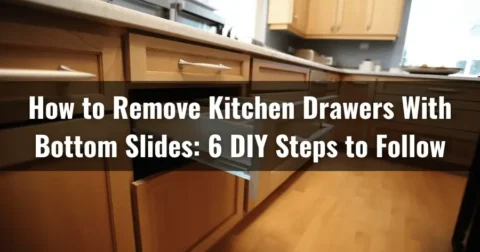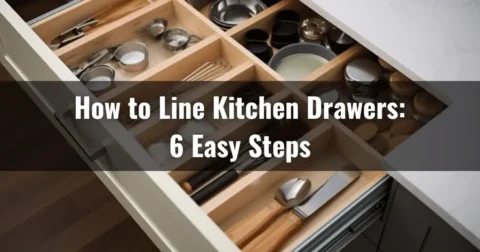You may be dealing with a faulty kitchen drawer that won’t stay shut and constantly opens by itself. It’s not only irritating but can also be dangerous when you’re cooking. But how do you fix a kitchen drawer that opens and stays shut?
Check if the drawer is properly installed and aligned. Look for any wear or damage in the runners or slides and fix or replace them as necessary. Proper weight distribution can also prevent unintended opening. And consider environmental factors such as temperature and moisture that could affect the drawer.
Here we will go through each of these methods in detail and provide useful tips to help you fix your self-opening kitchen drawer quickly and easily.
Guide to Fixing a Self-Opening Drawer

To fix a kitchen drawer that constantly opens by itself, here are some methods you can try. We listed the methods after extensive research and based on real user experiences.
- Method 01: Properly align and install the drawer
- Checking for misalignment or loose screws
- Adjusting the position of the drawer
- Method 02: Repairing or replacing drawer runners or slides
- Inspection of runners
- Tightening loose screws or replacing worn-out slides
- Method 03: Organizing items within the drawer for proper weight distribution
- Sorting and removing unnecessary items
- Distributing weight evenly
- Method 04: Applying fixes for environmental factors affecting the drawer
- Using moisture-absorbing packets
- Treating wooden drawers with sealants
A closer look at each method will help us understand it better.
Method 01: Properly Align and Install the Drawer
Checking for Misalignment or Loose Screws
Inspecting the drawer reveals any misalignments or loose screws that may be causing it to open by itself. Start by opening and closing the drawer several times, paying close attention to its movement. Look for any irregularities, such as a wobbly or shaky motion.
Also, thoroughly examine the screws on both sides of the drawer to ensure they are tightly secured. Loose screws can contribute to the drawer’s self-opening problem.
Adjusting the Position of the Drawer
After noticing any misalignment, loosen the screws holding the slides or runners. Gently adjust the position of the drawer to align it correctly. Securely tighten the screws.
To do this, carefully slide the drawer in and out to determine how much adjustment is needed. Once you have determined the correct position, we prefer a screwdriver to loosen the screws slightly. Move the drawer accordingly. Then, tighten all screws securely to ensure proper alignment.
Method 02: Repairing or Replacing Drawer Runners or Slides
Inspection of Runners
To inspect the drawer runners for any signs of damage or wear that might be causing your kitchen drawer to open on its own, closely examine them for any deformations or deterioration.
This can lead to issues with smooth operation. Look for any cracks, breaks, or warping in the runners. Also, we recommend making sure the runners are securely connected and properly aligned with the drawer by testing them with a gentle tug.
Replacing Worn-Out Slides
If your inspection reveals any signs of wear or damage, it may be necessary to replace the slides. In this case, look for drawer runners compatible with your kitchen drawers.
Once you have acquired new slides, open the drawer and remove the old ones. To install the replacement runners, attach them firmly to the cabinet floor before sliding them into the drawer.
After the drawer is in place, use screws to secure it to the cabinet frame. Lastly, ensure the runners are properly aligned and perform a test run on your kitchen drawers.
Method 03: Organizing Items Within the Drawer for Proper Weight Distribution:

Sorting and Removing Unnecessary Items
Let’s start by reviewing the items and removing any unnecessary or heavy objects to stop your kitchen drawer from self-opening.
Begin by emptying the drawer completely and carefully inspecting each item. Remove anything not essential for daily use or add excessive weight to the drawer.
In this case, we recommend donating or storing items elsewhere if they are rarely used but still hold sentimental value.
Distributing Weight Evenly
Ensure that you evenly distribute the weight of the items within your kitchen drawer to maintain balance and prevent any unexpected opening.
Start by organizing similar items together, placing heavier objects towards the back and lighter ones towards the front. Avoid overloading one side of the drawer, which can throw off its balance.
Consider using dividers or containers to separate different items and distribute weight evenly throughout the drawer.
Method 04: Applying Fixes for Environmental Factors Affecting the Drawer:
Using Moisture-Absorbing Packets
One simple solution for preventing a kitchen drawer from opening is using moisture-absorbing packets. Excessive humidity can cause wooden drawers to swell and interfere with smooth operation.
Placing moisture-absorbing packets or silica gel inside the drawer can combat humidity and prevent the drawer from opening independently. These packets work by absorbing excess moisture in the air, keeping your drawers dry and functioning properly.
Treating Wooden Drawers with Sealants
Take your wooden drawers to the next level of protection and beauty by treating them with sealants. This will keep them in top-notch condition.
Applying a sealant or finish enhances the appearance of the wood and acts as a barrier against moisture. This helps prevent swelling or sticking, ensuring the structural integrity of your kitchen drawer.
It is advisable to use a high-quality sealant to get the best results and follow the instructions carefully.
Tips for Preventing a Self-Opening Drawer in the Future
To prevent self-opening drawers in the future, we have compiled several key points for you to keep in mind.
- Regular maintenance and inspections
- Proper installation and alignment
- Avoid overloading the drawer
- Organize items thoughtfully
- Address environmental factors
Let’s examine each point in more detail.
i) Regular Maintenance and Inspections

Inspecting your kitchen drawers regularly helps ensure they remain aligned and functional, preventing them from opening on their own.
Periodically check for any signs of misalignment, loose screws, or wear and tear on the slides or runners. If you notice any issues, address them promptly before they worsen. Tighten any loose screws and replace any worn-out parts if necessary.
ii) Proper Installation and Alignment
It is crucial to ensure that your drawers are securely attached and sit evenly within the cabinet or frame. This will prevent any unnecessary movement or sliding, reducing the chances of your kitchen drawer opening by itself.
iii) Avoid Overloading the Drawer
By evenly distributing the weight and being mindful of what you place in the drawer, you can ensure its longevity and prevent potential misalignment or movement.
It is suggested that you avoid overloading the drawer with heavy items, as this can strain the runners and cause them to misalign over time. By distributing the weight evenly, you maintain balance and reduce the risk of the drawer opening by itself.
iv) Organize Items Thoughtfully
To keep your drawer organized and clutter-free, carefully arrange items so they are easily visible and accessible. Group similar items together, such as utensils or tools, to make finding them a breeze.
Use dividers or small containers to separate different categories of items and prevent them from shifting around. Consider labeling each section for even greater efficiency.
By organizing your drawer thoughtfully, it will be easier to move and open and will last longer. Also, you’ll save time in the long run because you won’t have to search for things as often.
v) Address Environmental Factors
To address environmental factors and protect your wooden drawer from potential damage, follow these steps:
- Combat high humidity by using moisture-absorbing packets or silica gel in areas prone to dampness.
- Avoid exposing the drawer to extreme temperature changes or direct sunlight, which can warp the wood and affect its performance.
Taking these measures will help preserve the functionality and longevity of your kitchen drawer. You won’t have to worry about the drawer opening on its own if you want to stay closed.
How Does Self Closing Drawer Hardware Work?
To understand how self-closing drawer hardware works, let’s break it down into four key points.
- Hydraulic dampers
- Spring mechanisms
- Drawer slides with integrated soft-close
- Drawer adjustment
Here’s a closer look at each component:
No 01: Hydraulic Dampers
Many self-closing kitchen drawer systems incorporate hydraulic dampers. These dampers are small devices filled with hydraulic fluid that create resistance when the drawer is closed. As the drawer approaches the fully closed position, the hydraulic dampers slow down the movement and gently pull it to a close.
No 02: Spring Mechanisms
Some self-closing kitchen drawer hardware also utilizes springs to assist in closing. These springs are typically positioned on the slides or runners and are compressed as the drawer is opened. When the user releases the drawer, the springs push the drawer back toward the closed position.
No 03: Drawer Slides with Integrated Soft-Close
There are drawer slides available that have the soft-close mechanism built into them. These slides have hydraulic dampers or springs integrated into the slide mechanism. When the kitchen drawer is pushed in, the soft-close feature engages automatically to close the drawer smoothly.
No 04: Drawer Adjustment

Self-closing kitchen drawer hardware may have some adjustability to control the closing speed and force. By adjusting the tension of the dampers or springs, you can customize the closing action to suit your preference.
FAQ’s: How to fix a kitchen drawer that opens by itself
We have gathered some common questions customers ask about self-closing kitchen drawers.
Can I retrofit my existing kitchen drawers with self-closing hardware?
Adding self-closing hardware to your existing drawers is an easy and affordable upgrade. Ensure your current drawers are in good condition and compatible with the new hardware.
We advise purchasing compatible slides or dampers and carefully follow the installation instructions. This will ensure that your drawers close smoothly and securely, giving you peace of mind in the kitchen.
Can temperature fluctuations affect my soft-close drawer’s performance?
Temperature fluctuations can have a minimal impact on the performance of soft-close drawers in your kitchen. While extreme temperature changes can affect the hydraulic dampers in the hardware, this effect is generally insignificant.
If you notice a change in the closing speed during seasonal shifts, it is likely due to temperature sensitivity. Yet, rest assured that this impact is usually minimal and should not cause significant issues with your soft-close drawer’s performance.
Why does my kitchen drawer suddenly stop halfway when I try to close it?
If your kitchen drawer suddenly stops halfway when you close it, you might be dealing with wood swelling because of a change in humidity or temperature, obstructed runner, or slide.
The first thing to check is for any debris or objects blocking the smooth closure. Remove anything causing the obstruction and try closing the drawer again.
If the problem persists, inspect the runner and slide for signs of wear or misalignment. Adjust or replace them if necessary to ensure the smooth operation of your kitchen drawer.
Conclusion
As you can see, fixing a kitchen drawer that opens by itself is not as difficult as it may seem. By following the tips and tricks outlined here, you can quickly and easily address the underlying issues and prevent future problems from arising.
Remember to check for proper installation and alignment, inspect the runners and slides, consider environmental factors like humidity, and distribute weight evenly.
Taking preventive measures like organizing items and regular maintenance can further prevent future issues. So, don’t let a faulty kitchen drawer spoil your cooking experience. Give it a try, and say goodbye to that pesky self-opening drawer once and for all.





